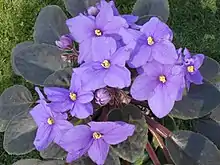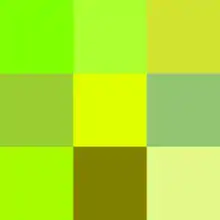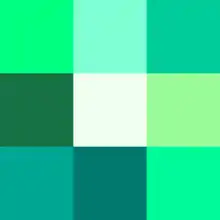Shades of violet
There are numerous variations of the color violet, a sampling of which are shown below.
| Violet | |
|---|---|
| Spectral coordinates | |
| Wavelength | 380–450 nm |
| Frequency | 800–715 THz |
| Hex triplet | #7F00FF |
| HSV (h, s, v) | (270°, 100%, 100%) |
| sRGBB (r, g, b) | (127, 0, 255) |
| Source | 99Colors[1] |
| B: Normalized to [0–255] (byte) H: Normalized to [0–100] (hundred) | |
Violet in human culture
Wrapping the spectrum into a color wheel

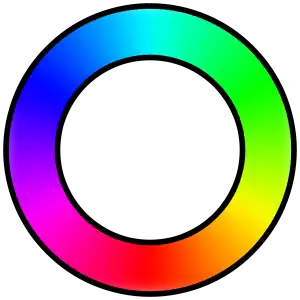
In a color proximity sense, a primary color has a color range of 120° (60° on each side of the color's hue) and any color has to be within that range to be considered a variation of that color. Secondary colors have a color range of 60° (30°), tertiary colors have a color range of 30° (15°), quaternary colors have a color range of 15° (7.5°), quinary colors have a color range of 7.5° (3.75°), and so on. Because violet is located at a hue angle of 270°, it has a tertiary color range of 255° and 285°, and any color out of this range is more related to blue or magenta than violet. If the visible spectrum is wrapped to form a color wheel, violet (additive secondary) appears midway between blue and magenta:
Variations of the color violet
Variations of spectral violet
Although pure spectrum violet is outside the color gamut of the RGB color space, the three colors displayed below are rough approximations of the range of colors of actual spectral violet, although the accuracy of the approximation can vary depending on the individual's color vision, and on the color rendition of one's computer monitor.
Violet Flower
| Violet | |
|---|---|
| Hex triplet | #7F00FF |
| HSV (h, s, v) | (270°, 100%, 100%) |
| sRGBB (r, g, b) | (127, 0, 255) |
| Source | 99Colors[2] |
| B: Normalized to [0–255] (byte) H: Normalized to [0–100] (hundred) | |
.jpg.webp)
Violet is a color derived from the flower of the same name.
Color wheel violet
| Violet (color wheel) | |
|---|---|
| Hex triplet | #7F00FF |
| HSV (h, s, v) | (270°, 100%, 100[3]%) |
| sRGBB (r, g, b) | (127, 0, 255) |
| Source | HTML Color Chart[4] |
| ISCC–NBS descriptor | Vivid violet |
| B: Normalized to [0–255] (byte) H: Normalized to [0–100] (hundred) | |
The tertiary color on the HSV color wheel (also known as the RGB color wheel) precisely halfway between blue and magenta is called color wheel violet. This tone of violet—an approximation of the color violet at about 417 nanometers as plotted on the CIE chromaticity diagram—is shown at right. This tone of violet is actually somewhat toward indigo assuming indigo is accepted as a separate spectrum color, usually quoted as having a range of from about 420 to 450 nanometers.[5] Another name for this color is near violet.
Electric violet
| Electric Violet | |
|---|---|
| Hex triplet | #8F00FF |
| HSV (h, s, v) | (274°, 100%, 100[6]%) |
| sRGBB (r, g, b) | (143, 0, 255) |
| Source | HTML Color Chart @274 |
| ISCC–NBS descriptor | Vivid violet |
| B: Normalized to [0–255] (byte) H: Normalized to [0–100] (hundred) | |
The color at right, electric violet, is the closest approximation to middle spectrum violet that can be made on a computer screen, given the limitations of the sRGB color gamut. It is an approximation of the color violet at about 400 nanometers as plotted on the CIE chromaticity diagram, in the middle of the violet range of from 380 nanometers to 420 nanometers, assuming indigo as a separate spectrum color from 420 to 450 nanometers.[5] Other names for this color are middle violet or simply violet.
Vivid violet
| Vivid Violet | |
|---|---|
| Hex triplet | #9F00FF |
| HSV (h, s, v) | (277°, 100%, 100[7]%) |
| sRGBB (r, g, b) | (159, 0, 255) |
| Source | HTML Color Chart @277 |
| ISCC–NBS descriptor | Vivid violet |
| B: Normalized to [0–255] (byte) H: Normalized to [0–100] (hundred) | |
Displayed at right is the color vivid violet, a color approximately equivalent to the violet seen at the extreme edge of human visual perception. When plotted on the CIE chromaticity diagram, it can be seen that this is a hue corresponding to that of a visual stimulus of approximately 380 nm on the spectrum. Thus another name for this color is extreme violet.
Web color "violet"
The so-called web color "violet" is in actuality not really a tint of violet, a spectral color, but is a non-spectral color. The web color violet is actually a rather pale tint of magenta because it has equal amounts of red and blue (the definition of magenta for computer display), and some of the green primary mixed in, unlike most other variants of violet that are closer to blue. This same color appears as "violet" in the X11 color names.
| Dark Violet | |
|---|---|
| Hex triplet | #9400D3 |
| HSV (h, s, v) | (282°, 100%, 83[8]%) |
| sRGBB (r, g, b) | (148, 0, 211) |
| Source | X11 |
| ISCC–NBS descriptor | Vivid violet |
| B: Normalized to [0–255] (byte) H: Normalized to [0–100] (hundred) | |
Pigment violet (web color dark violet)
The color box at right displays the web color dark violet which is equivalent to pigment violet, i.e., the color violet as it would typically be reproduced by artist's paints, colored pencils, or crayons as opposed to the brighter "electric" violet above that it is possible to reproduce on a computer screen.
Compare the subtractive colors to the additive colors in the two primary color charts in the article on primary colors to see the distinction between electric colors as reproducible from light on a computer screen (additive colors) and the pigment colors reproducible with pigments (subtractive colors); the additive colors are a lot brighter because they are produced from light instead of pigment.
Pigment violet (web color dark violet) represents the way the color violet was always reproduced in pigments, paints, or colored pencils in the 1950s. By the 1970s, because of the advent of psychedelic art, artists became used to brighter pigments, and pigments called "Violet" that are the pigment equivalent of the electric violet reproduced in the section above became available in artists pigments and colored pencils. (When approximating electric violet in artists pigments, a bit of white pigment is added to pigment violet.)
Mauve
| Mauve (Mallow) | |
|---|---|
| Hex triplet | #E0B0FF |
| HSV (h, s, v) | (276°, 31%, 100[9]%) |
| sRGBB (r, g, b) | (224, 176, 255) |
| Source | Maerz and Paul[10] |
| ISCC–NBS descriptor | Brilliant purple |
| B: Normalized to [0–255] (byte) H: Normalized to [0–100] (hundred) | |
Mauve (from the French form of Malva "mallow") is a color that is named after the mallow flower. Another name for the color is mallow[11] with the first recorded use of mallow as a color name in English in 1611.[12]
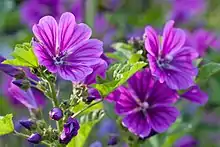
Since the color mauve has a hue code of 276, it may be regarded as a pale tone of violet.
Lavender
| Lavender | |
|---|---|
| Hex triplet | #B57EDC |
| HSV (h, s, v) | (275°, 43%, 86[13]%) |
| sRGBB (r, g, b) | (181, 126, 220) |
| Source | Maerz and Paul[14] |
| ISCC–NBS descriptor | Strong purple |
| B: Normalized to [0–255] (byte) H: Normalized to [0–100] (hundred) | |
At right is displayed the color lavender. This color may also be called lavender (floral) or floral lavender to distinguish it from the web color lavender. It is the color of the central part of the lavender flower.
The first recorded use of the word lavender as a color term in English was in 1705.[15]

Since the color lavender has a hue code of 275, it may be regarded as a light tone of violet.
Wisteria
| Wisteria | |
|---|---|
| Hex triplet | #C9A0DC |
| HSV (h, s, v) | (281°, 27%, 86%) |
| sRGBB (r, g, b) | (201, 160, 220) |
| Source | Crayola |
| ISCC–NBS descriptor | Light purple |
| B: Normalized to [0–255] (byte) H: Normalized to [0–100] (hundred) | |
Displayed at right is the color wisteria.
It represents the color of wisteria blooms. A crayon of this color and name was formulated by Crayola in 1993.
French violet
| French Violet | |
|---|---|
| Hex triplet | #8806CE |
| HSV (h, s, v) | (279°, 97%, 81%) |
| sRGBB (r, g, b) | (136, 6, 206) |
| Source | Pourpre.com |
| ISCC–NBS descriptor | Vivid violet |
| B: Normalized to [0–255] (byte) H: Normalized to [0–100] (hundred) | |
At right is displayed the color French violet, which is the tone of violet that is called violet in the Pourpre.com color list, a color list widely popular in France.
Ultra Violet (Pantone)
| Ultra Violet | |
|---|---|
| Hex triplet | #645394 |
| HSV (h, s, v) | (256°, 44%, 58[16]%) |
| sRGBB (r, g, b) | (100, 83, 148) |
| Source | Pantone TPX[17] |
| ISCC–NBS descriptor | Moderate violet |
| B: Normalized to [0–255] (byte) H: Normalized to [0–100] (hundred) | |
The color Ultra Violet is displayed at right.
The source of this color is the "Pantone Textile Paper eXtended (TPX)" color list, color #18-3838 TPX—Ultra Violet.[18]
Ultra Violet was named as Pantone's Color of the Year for 2018.[19]
Grape
| Grape | |
|---|---|
| Hex triplet | #6F2DA8 |
| HSV (h, s, v) | (272°, 73%, 65%) |
| sRGBB (r, g, b) | (111, 45, 168) |
| Source | Crayola |
| ISCC–NBS descriptor | Vivid violet |
| B: Normalized to [0–255] (byte) H: Normalized to [0–100] (hundred) | |
Grape is a color that is a representation of the color of grapes.

In 1994, "grape" was formulated as one of the Crayola Magic Scent crayon colors.
Spanish violet
| Violet (G&S) | |
|---|---|
| Hex triplet | #4C2882 |
| HSV (h, s, v) | (264°, 69%, 51%) |
| sRGBB (r, g, b) | (76, 40, 130) |
| Source | Gallego and Sanz[20] |
| ISCC–NBS descriptor | Deep violet |
| B: Normalized to [0–255] (byte) H: Normalized to [0–100] (hundred) | |
Spanish violet is the color that is called Violeta (the Spanish word for "violet") in the Guía de coloraciones (Guide to colorations) by Rosa Gallego and Juan Carlos Sanz, a color dictionary published in 2005 that is widely popular in the Hispanophone realm.
Russian violet
| Russian Violet | |
|---|---|
| Hex triplet | #32174D |
| HSV (h, s, v) | (270°, 70%, 30%) |
| sRGBB (r, g, b) | (50, 23, 77) |
| Source | ISCC-NBS |
| ISCC–NBS descriptor | Deep violet |
| B: Normalized to [0–255] (byte) H: Normalized to [0–100] (hundred) | |
The color Russian violet is displayed at right.
The first recorded use of Russian violet as a color name in English was in 1926.[21]
African violet
| African Violet | |
|---|---|
| Hex triplet | #B284BE |
| HSV (h, s, v) | (288°, 31%, 75[22]%) |
| sRGBB (r, g, b) | (178, 132, 190) |
| Source | Pantone TPX[23] |
| ISCC–NBS descriptor | Light purple |
| B: Normalized to [0–255] (byte) H: Normalized to [0–100] (hundred) | |
The color African violet is displayed at right.
The source of this color is the "Pantone Textile Paper eXtended (TPX)" color list, color #16-3250 TPX—African Violet.[24]
English violet
| English Violet | |
|---|---|
| Hex triplet | #563C5C |
| HSV (h, s, v) | (289°, 35%, 36%) |
| sRGBB (r, g, b) | (86, 60, 92) |
| Source | ISCC-NBS |
| ISCC–NBS descriptor | Dark purple |
| B: Normalized to [0–255] (byte) H: Normalized to [0–100] (hundred) | |
The color English violet is displayed at right.
The first recorded use of English violet as a color name in English was in 1928.[25]
Chinese violet
| Chinese Violet | |
|---|---|
| Hex triplet | #856088 |
| HSV (h, s, v) | (296°, 29%, 53[26]%) |
| sRGBB (r, g, b) | (133, 96, 136) |
| Source | Pantone TPX[27] |
| ISCC–NBS descriptor | Moderate purple |
| B: Normalized to [0–255] (byte) H: Normalized to [0–100] (hundred) | |
The color Chinese violet is displayed at right.
The first recorded use of Chinese violet as a color name in English was in 1912.[28]
The source of this color is the "Pantone Textile Paper eXtended (TPX)" color list, color #18-3418 TPX—Chinese Violet.[29]
Computer web color violets
| Violet (web color) | |
|---|---|
| Hex triplet | #EE82EE |
| HSV (h, s, v) | (300°, 45%, 93[30]%) |
| sRGBB (r, g, b) | (238, 130, 238) |
| Source | X11[31] X11 color names[32] |
| ISCC–NBS descriptor | Vivid purple |
| B: Normalized to [0–255] (byte) | |
Japanese violet
| Violet (JTC) | |
|---|---|
| Hex triplet | #5B3256 |
| HSV (h, s, v) | (307°, 45%, 36[33]%) |
| sRGBB (r, g, b) | (91, 50, 86) |
| Source | JTC |
| ISCC–NBS descriptor | Dark reddish purple |
| B: Normalized to [0–255] (byte) H: Normalized to [0–100] (hundred) | |
The color Japanese violet is shown at right.
This is the color called "violet" in the traditional Japanese colors group, a group of colors in use since beginning in 660 CE in the form of various dyes that are used in designing kimono.[34][35]
The name of this color in Japanese is sumire-iro, meaning "violet color".
See also
References
- "Color Violet". Retrieved 18 May 2018.
- "Color Violet". Retrieved 18 May 2018.
- Forret, Peter. "RGB Color converter - toolstudio". Web.forret.com. Retrieved 20 November 2017.
- In the HSV color space, mapped by the sRGB color rendition system, the color violet (color wheel) is defined as the color with a hue of 270 degrees, which is the color exactly half way between blue and magenta on the RGB color wheel.
- Rosen, Joe (20 November 2017). Encyclopedia of Physics. Infobase Publishing. ISBN 9781438110134. Retrieved 20 November 2017 – via Google Books.
- Forret, Peter. "RGB Color converter - toolstudio". Web.forret.com. Retrieved 20 November 2017.
- Forret, Peter. "RGB Color converter - toolstudio". Web.forret.com. Retrieved 20 November 2017.
- Forret, Peter. "RGB Color converter - toolstudio". Web.forret.com. Retrieved 20 November 2017.
- Forret, Peter. "RGB Color converter - toolstudio". Web.forret.com. Retrieved 20 November 2017.
- The color displayed in the color box above matches the color called mauve in the 1930 book by Maerz and Paul A Dictionary of Color New York:1930 McGraw-Hill; the color "mallow" is displayed on Page 125, Plate 51, Color Sample I3 Note: It is stated in A Dictionary of Color that mallow and mauve are two different names used in English to refer to exactly the same color--the name mallow came into use in 1611 and mauve came into use as its synonym in 1856--see under the entry for each name on page 198 in the Index. See also discussion of the color Mallow (Mauve) on page 166.
- Maerz and Paul A Dictionary of Color New York:1930 McGraw-Hill Page 198
- Maerz and Paul A Dictionary of Color New York:1930 McGraw-Hill Page 198; Color Sample of Mallow: Page 125 Plate 51 Color Sample I3
- Forret, Peter. "RGB Color converter - toolstudio". Web.forret.com. Retrieved 20 November 2017.
- The color displayed in the color box above matches the color called lavender in the 1930 book by Maerz and Paul A Dictionary of Color New York:1930 McGraw-Hill; the color lavender is displayed on page 109, Plate 43, Color Sample C5.
- Maerz and Paul A Dictionary of Color New York: 1930 McGraw-Hill Page 197
- Forret, Peter. "RGB Color converter - toolstudio". Web.forret.com. Retrieved 20 November 2017.
- Type the words "Ultra Violet" into the indicated window on the Pantone Color Finder and the color will appear.
- Pantone TPX Pantone Color Finder Type the words "Ultra Violet" into the indicated window on the Pantone Color Finder and the color will appear
- "Pantone Color of the Year 2018 | Ultra Violet 18-3838". Pantone. Retrieved February 3, 2018.
- Gallego, Rosa; Sanz, Juan Carlos (2005). Guía de coloraciones (Gallego, Rosa; Sanz, Juan Carlos (2005). Guide to Colorations) Madrid: H. Blume. ISBN 84-89840-31-8
- Maerz and Paul A Dictionary of Color New York:1930 McGraw-Hill Page 194; Color Sample of Russian Violet: Page 111 Plate 44 Color Sample K11
- Forret, Peter. "RGB Color converter - toolstudio". Web.forret.com. Retrieved 20 November 2017.
- Type the words "African Violet" into the indicated window on the Pantone Color Finder and the color will appear.
- Pantone TPX Pantone Color Finder
- Maerz and Paul A Dictionary of Color New York:1930 McGraw-Hill Page 194; Color Sample of English Violet: Page 111 Plate 44 Color Sample K9
- Forret, Peter. "RGB Color converter - toolstudio". Web.forret.com. Retrieved 20 November 2017.
- Type the words "Chinese Violet" into the indicated window on the Pantone Color Finder and the color will appear.
- Maerz and Paul A Dictionary of Color New York:1930 McGraw-Hill Page 192; Color Sample of Chinese Violet: Page 107 Plate 42 Color Sample I7
- Pantone TPX Pantone Color Finder Type the words "Chinese Violet" into the indicated window on the Pantone Color Finder and the color will appear
- Forret, Peter. "RGB Color converter - toolstudio". Web.forret.com. Retrieved 20 November 2017.
- W3C TR CSS3 Color Module, SVG color keywords. W3C. (May 2003). Retrieved on 30 January 2008.
- "X11 rgb.txt". Archived from the original on 2015-11-07.
- Forret, Peter. "RGB Color converter - toolstudio". Web.forret.com. Retrieved 20 November 2017.
- Nagasaki, Seiki. Nihon no dentoshoku : sono shikimei to shikicho, Seigensha, 2001. ISBN 4-916094-53-0
- Nihon Shikisai Gakkai. Shinpen shikisai kagaku handobukku, Tokyo Daigaku Shuppankai, 1985. ISBN 4-13-061000-7

